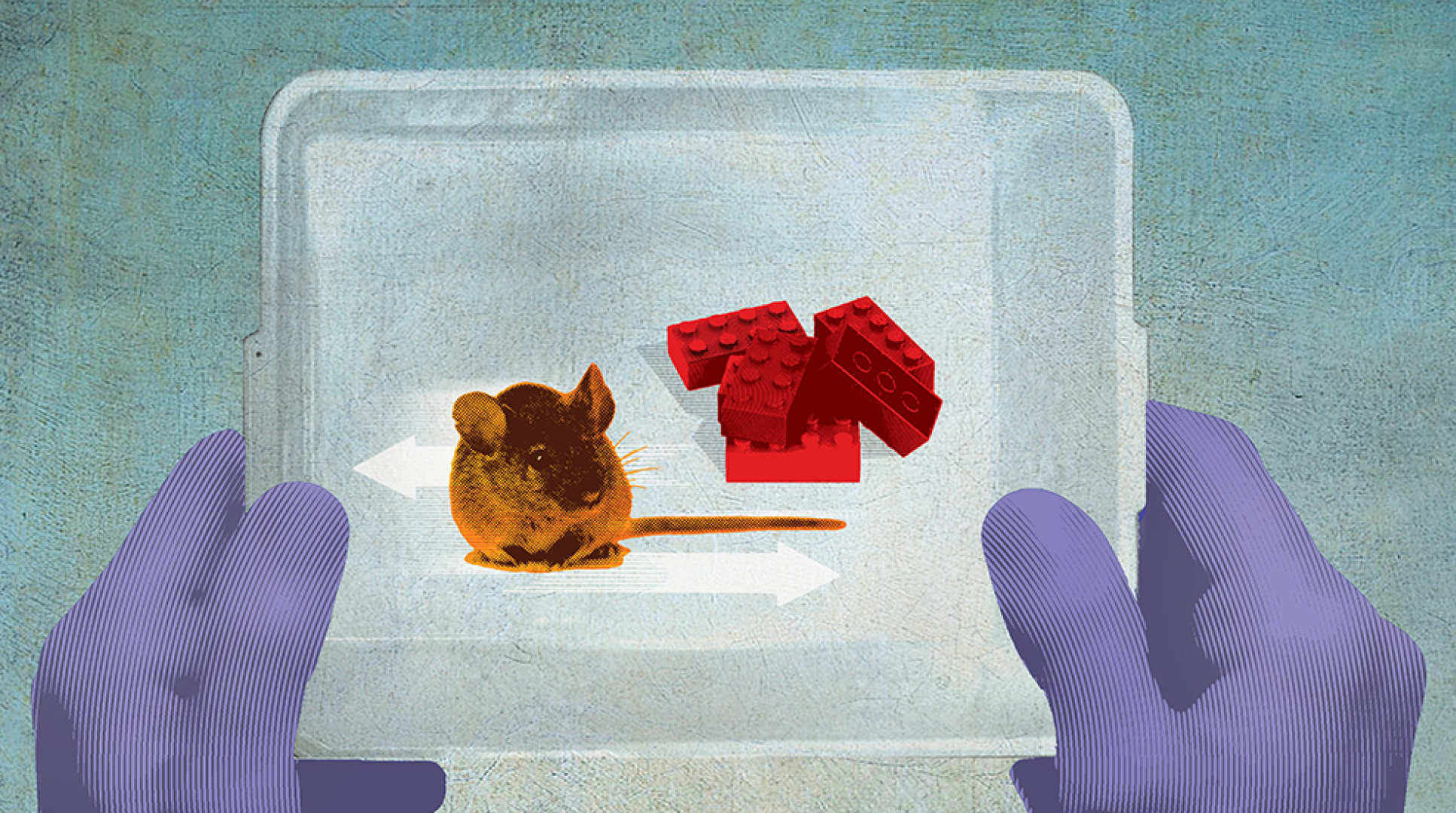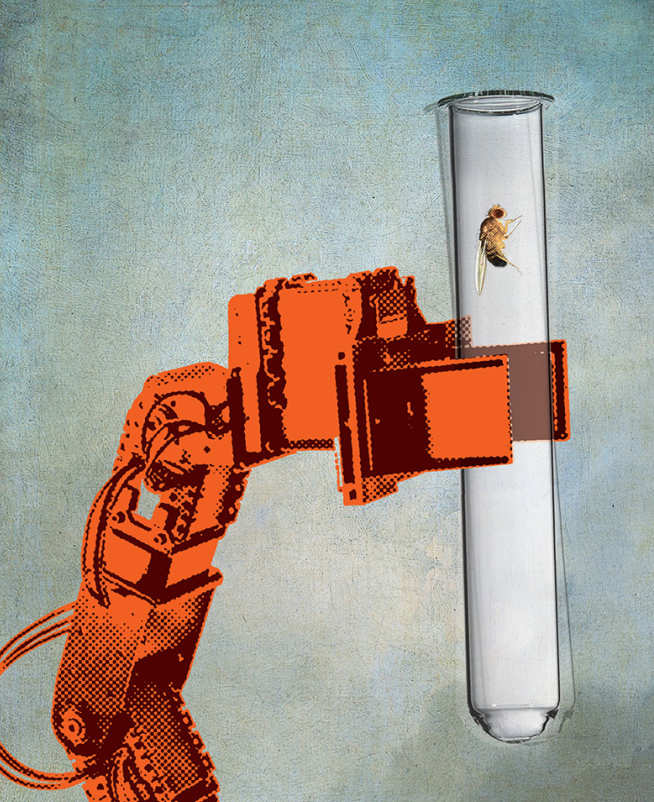A good night's sleep
What do Lego, mice and fruit flies have in common? At Imperial, they are all playing their part to unlock the mysteries of sleep.
Words: Lucy Jolin / Illustration: Andy Martin

We spend a third of our lives doing it – more than on any other activity. We know that we need it: if we don’t get enough, the consequences can be far-reaching and even fatal. And we know that the drive to do it is irresistible: however much we fight it, it will eventually come. Sleep: one of the great unsolved scientific mysteries of our time. And working out ways to unravel its secrets is as complex as the act itself.
“Ask people what sleep is for, and they will say: ‘Getting some rest.’ But that is not really a satisfactory answer from the biological point of view,” says Professor Giorgio Gilestro, a lecturer in the Department of Life Sciences, who believes an over-emphasis on studying brain signals has compromised sleep research. “Compare sleep with feeding. We know, at the biological level, what feeding is for. We know that when you ingest food you do so because your body needs calories to function. We know exactly how sugar transforms itself in order to give you fuel. We don’t have a conceptual equivalent for sleep.”
But there are two new secret weapons in the battle to uncover sleep’s mysteries from a genetic standpoint: fruit flies and mice.
Like humans, Drosophila melanogaster (the common fruit fly) have around 20,000 genes, 70 per cent of which they share with humans, making them a perfect model for studying how genes affect sleep.
“We now have tools that allow us to destroy the genes one by one and then check each one for a given pattern or phenotype,” explains Gilestro. “We recently found the gene that, when mutated, will make flies sleep less. We proposed that it’s important in merging together circadian rhythms, which regulate the time of the day when you have to sleep, together with sleep homeostasis, which regulates how tired you are.” They called the gene Ninna nanna, Italian for lullaby.
Awake to the dangers
Along with genetic technology, automation has been key to allowing proper investigation of sleep. In Gilestro’s lab, 70 specially built robots take on repetitive tasks formerly performed by students: they move the flies’ jars to wake them up when they start sleeping, puff odours in to sexually arouse them, and record their levels of movement.
Any experiment predicated on a student’s ability to shake a jar at exactly the same time and with the same force over an extended time period is never going to give accurate results. Research performed in this way in the US, aimed at seeing how long flies could go without sleep, found that some died after 60 hours. Gilestro replicated the experiment with his robots. After five weeks of sleep deprivation, giving the flies no more than 20 seconds of consecutive sleep, none had died.
“And this opens up new hypotheses – one of which is that sleep is not a vital necessity, at least for flies,” says Gilestro. “Or another is that animals enter episodes of sleep whether they want to or not. We keep them awake and they have microsleep episodes in order not to die.” These episodes have far-reaching implications for humans: for instance, an investigation found that Alfred Dorris probably drifted into a microsleep in 2016 while driving a tram in Croydon, London: the resulting crash killed seven people and injured 62.
Professor Nick Franks and Professor William Wisden’s work also involves keeping things awake: in their case, mice, who are sufficiently excited by a piece of Lego popped in their cage every hour or so. Their research into sleep has thus far focused on the probable overlap between the brain pathways that sedatives work on, and the brain pathways that induce natural sleep.
“There’s interest in sedative drugs or anaesthetics used in investigative or therapeutic procedures that produce a sedative state, but that don’t have side effects,” says Franks. “You always feel better after a good night’s sleep, but not after a sedative. Having a sedative drug that puts you in a deep but rousable sedative state, and that might even give some of the restorative benefits of natural sleep, would be very attractive clinically.”
Their new project, however, is founded on the observation that almost every neurological disorder – Alzheimer’s disease, schizophrenia, depression – presents with bad sleep. Are those conditions causing bad sleep? Or is the bad sleep itself causing the disorder? This is the question that their new research, funded by the UK Dementia Research Institute, will investigate: whether sleep is helping toxins such as beta-amyloid proteins, which have been associated with Alzheimer’s, get cleared from the brain. “The idea is that if you have healthy sleep during your lifetime, it may lower your risk of dementia,” says Wisden.
It’s one thing to study a jar of sleeping flies or a mouse; quite another to study a sleeping human. Studying how individuals sleep is vital not just for research, but also for diagnosis of a particular sleep problem.
Dr Parviz Habibi, co-founder with Dr James Di Pasquale (PhD Clinical Medicine Research 2017) of the Imperial College London Centre for Paediatric Sleep Science and Medicine at St Mary’s Hospital, are trying to find a solution. Their lab consists of two spacious bedrooms connected by an observation room. Every night, from around 7pm, children with a range of sleep problems – from respiratory difficulties such as obstructive sleep apnoea (OSA) to night terrors – and their parents arrive to have the child’s sleep observed.
Polysomnography sensors are attached to the child’s scalp and face to collect a sample of the brain’s electrical brain signals (EEG). If the child has breathing problems, they may also need: a nasal pressure cannula to detect airflow through the nose; a heart rate monitor; a respiratory effort band, which is like a belt; and a pulse sensor on the finger. Then they have to have a restful night’s sleep. It’s a less than ideal method, says Di Pasquale, especially for paediatrics. “A three-year-old often can’t understand or be convinced that this is a good idea.”
To that end, he and Habibi are researching a new innovation developed by Colin Sullivan at the University of Sydney: the Sonomat, a mat designed to fit over a mattress, which contains sensors similar to stethoscopes. These record sounds during sleep such as coughing, sneezing, wheezing, crackles, scratching and snoring, all of which could indicate a sleep problem. However, it can’t measure some indicators, such as oxygen levels, and it can’t be used to diagnose neurological sleep disorders. Something else is needed, and Professor Esther Rodriguez Villegas, Chair of Low Power Electronics in the Department of Electrical and Electronic Engineering, may have the solution.
“When you affect behaviour by studying it, you are not going to get the best conclusions,” she points out. “This happens not just in research, but also in diagnosis. To study sleep, you have to have sensors attached to the body that don’t detach, or change position, or affect sleep behaviour. You need wearable technology that people forget they are wearing.”
Creating a new playing field

Villegas and her team have come up with a wearable sensor that will be on the market in 2019 – again, for diagnosing OSA. They are currently working on the next bit of tech, which monitors brainwaves while algorithms detect different stages of sleep – the first stage, the rapid eye movement (REM) stage of deep sleep, and episodes known as sleep spindles, which correlate with a number of neurologically based conditions such as epilepsy, currently diagnosed in hospitals using EEG.
Villegas hopes that these wearables will open up many different areas of research. “It’s going to allow easy signal acquisitions,” she points out. “We know that sleep spindle activity changes in people with depression but we don’t know if that’s caused by depression, or the other way around. The question now is how we acquire more than one physiological parameter for sleep, from just one location in the body. We are not going to be able to detect respiration and brainwaves from the same location, but for everything else, there’s nothing that makes it physically impossible. What is that place?”
So many problems, so many questions: it might seem that the conundrum of why we sleep is insurmountable. However, with disciplines from engineering to paediatrics coming together to find answers, it may well be that sleep starts to yield its secrets soon.
“I wouldn’t be so ambitious or naive to say we are close to solving it,” says Gilestro. “But I’m very proud of the fact that we are creating a new playing field. We are creating new rules and questions and a new way of looking at the problem.”


